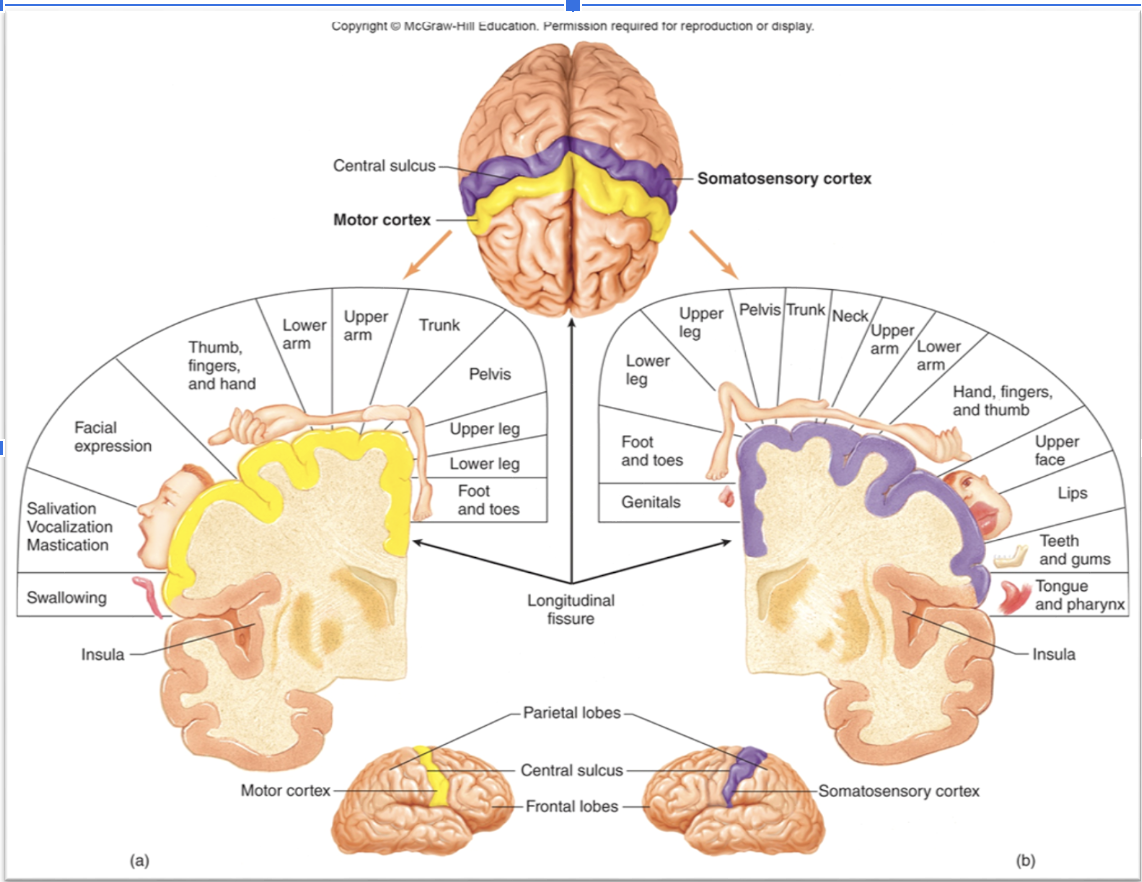Chapter 15 - Sensory Pathways & the Somatic Nervous System
1/53
There's no tags or description
Looks like no tags are added yet.
Name | Mastery | Learn | Test | Matching | Spaced |
|---|
No study sessions yet.
54 Terms
What are sensory pathways?
Like highways for information from your body to the (CNS)
What are sensory receptors?
Specialized neurons/cells that act like sensors the detect things like touch, temperature, and pain
What happens when sensory receptors are stimulated?
They generate action potentials (electrical messages) that travel along sensory pathways
What is the difference between somatic and visceral information in afferent pathways?
Somatic info comes from the body to the cerebral cortex, and visceral info comes from organs to the brainstem.
What do efferent pathways control?
Skeletal muscles by sending motor commands from the CNS to your muscles
What is the difference between sensation and perception?
Sensation - Sensory information arriving in CNS (Receiving signal)
Perception - Conscious awareness of a sensation (Understanding the signal) by feeling pain/pressure
What are general senses?
Temperature, pain, touch, pressure, vibration (Detect simple sensations)
What are special senses?
Smell, taste, vision, balance, hearing (Found in specific organs/detect more advanced sensations)
What are special sensory receptors?
Provide sensations of the special senses (ex: Eyes for vision)
What are the sensory receptor classifications?
Thermoreceptors
Chemoreceptors
Mechanoreceptors
Nociceptors
What do thermoreceptors, chemoreceptors, mechanoreceptors, and nociceptors detect?
Thermoreceptors detect temperature, chemoreceptors detect chemicals, mechanoreceptors detect physical changes, and nociceptors detect pain.
What do you know about detection of stimuli?
Each receptor is specific to a certain type of stimulus
What is a receptive field?
The area a receptor monitors
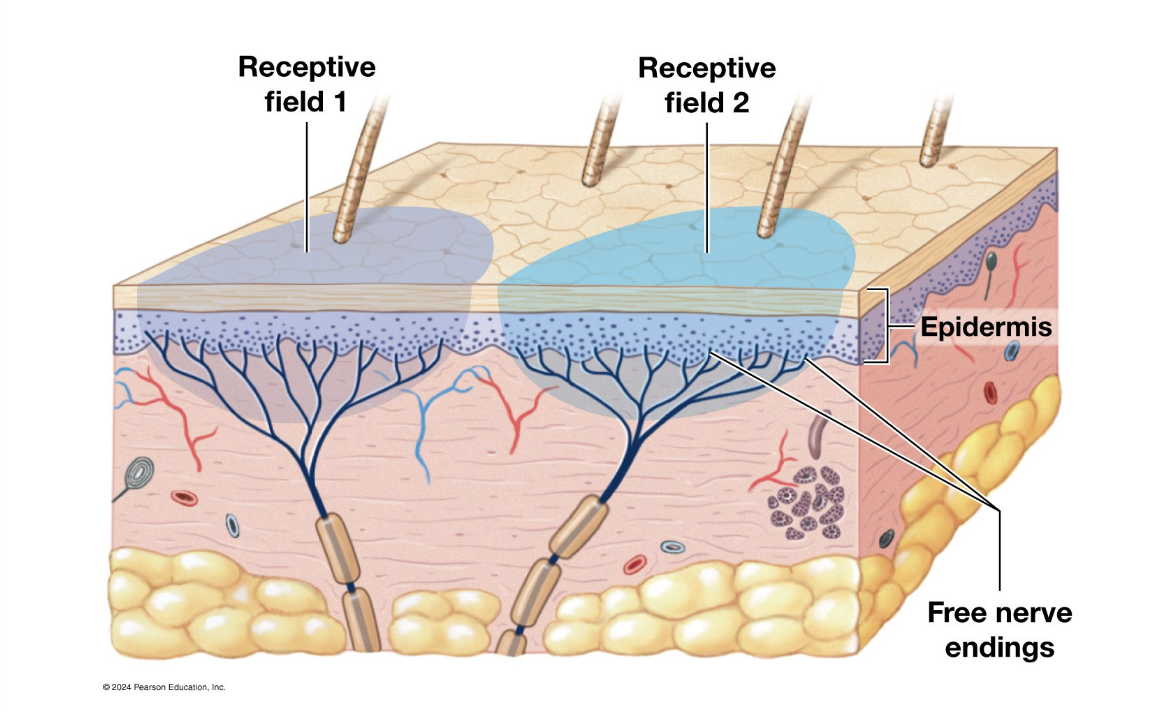
What happens when a receptive field is large?
More difficult to pinpoint source of stimulus
What is a sensory unit?
Sensation created by a sensory neuron and all it’s receptors

What receptive field would your finger have?
Small receptive field (Easy detection of stimuli)
What receptive field would you forearm have?
Large receptive field (Harder to detect stimuli)
What is two point touch threshold?
Test how sensitive an area is to touch by testing if you can feel 2 separate points
If you have a smaller receptive field you can feel
better you can feel 2 separate points of touch
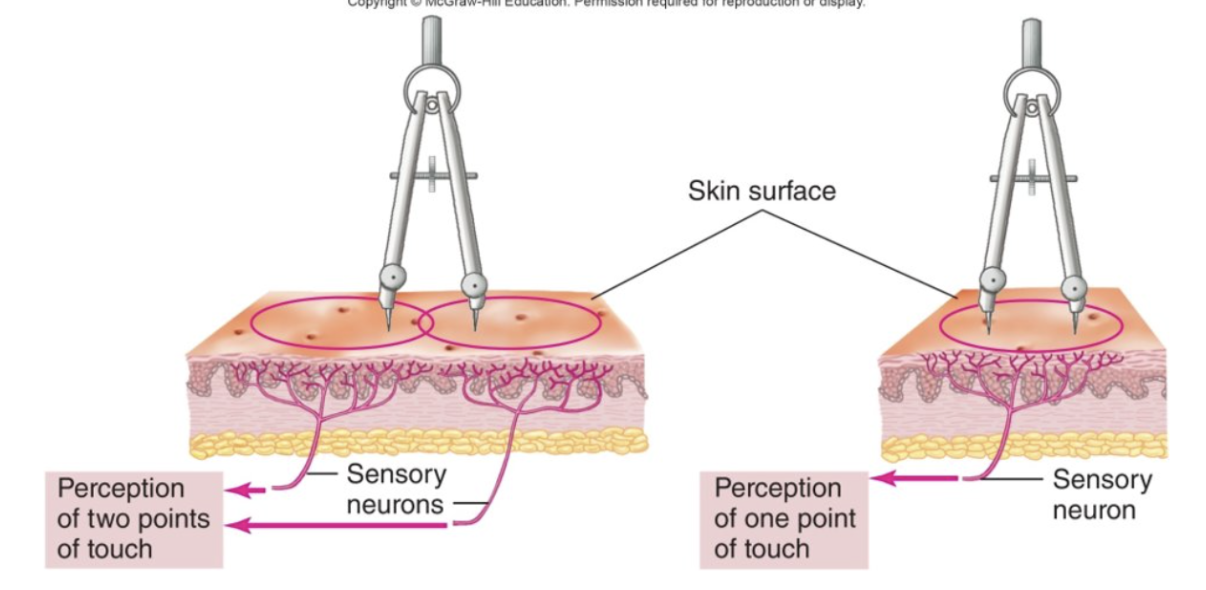
If you have a larger receptive field you would feel
Only 1 feel point touch
What do receptors do in receptor potentials?
Receptors convert stimulus to an action potential
What happens during depolarizing?
(Becoming more positive which is changing charge. From negative to positive) stimulus brings membrane closer to threshold (Closer to action potential)
What happens during Hyperpolarizing?
stimuli (Becoming more negative) brings membrane farther away from threshold (Farther from the action potential)
What is sensory adaptation?
When your receptors stop responding to a constant stimulus (Ex: When you stop noticing the feel of your clothes)
What is Phasic receptors? give example
Only active when a stimulus changes. Fast adapting. Usually inactive. Action potentials are generated in response to a change.
Ex: You put on a watch. You notice & feel the watch at first —> You adapt and don’t feel it anymore —> you take off the watch and you feel no watch.
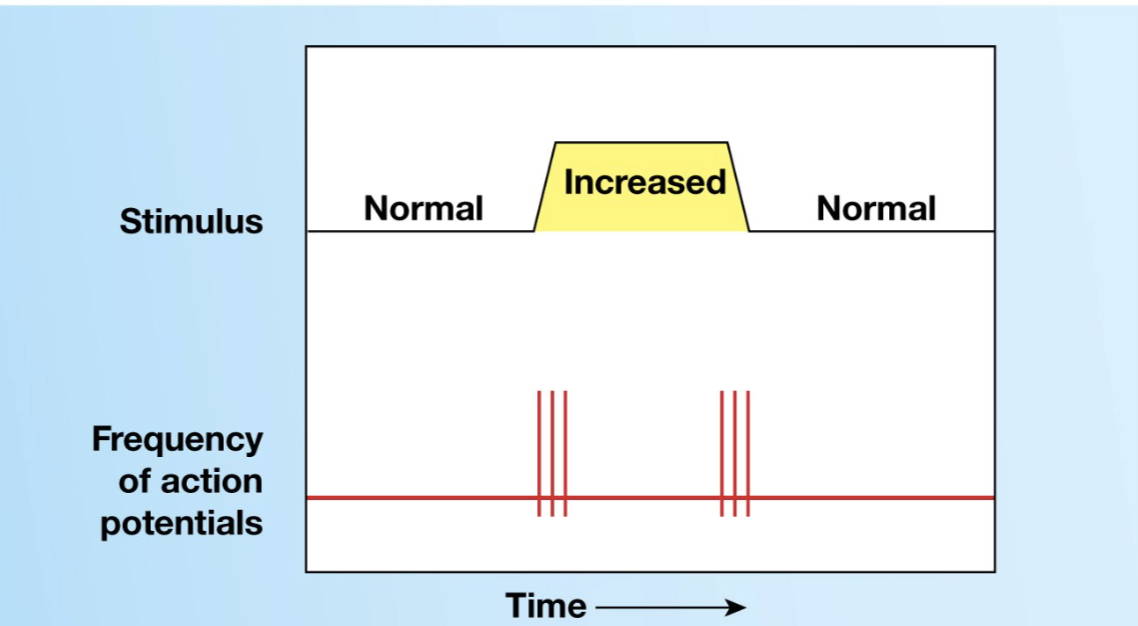
What are tonic receptors? give example
Always active & slow to adapt. Slow adapting
When stimulus changes, action potential changes accordingly
Ex: Itchy tag, you will itch until you take it off
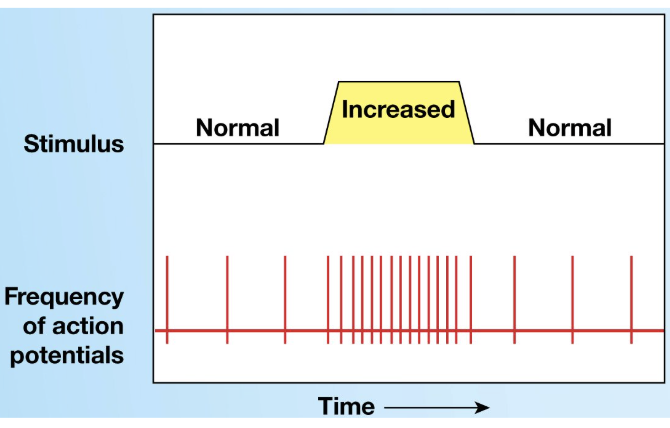
What are the general sensory receptors by the location of the stimulus, what do they detect?
Exteroceptors - Provide/detect info about external environment
Proprioceptors - Provide/detect info about body position/movement of skeletal muscles
Interoceptors - Provide/detect info about visceral (internal) organs
What are the general sensory receptors by nature of stimulus? and what do they do?
Nociceptors - Detect pain
Thermoreceptors - Detect temperature
Mechanoreceptors - Detect physical distortion such as touch
Chemoreceptors - Detect chemical concentration
Nocieptors are what type of receptors?
Pain receptors
Nocieptors detect what and its caused by?
Detects pain caused by damage or harmful stimuli (Heat, cold, pressure, chemicals)
Nociceptors have what type of nerve endings and what type of receptive field?
Free nerves endings with large receptive fields
Where are Nocieptors found?
Found in areas prone to injury (Skin, joints, blood vessels)
Nocieptors have what type of receptor? give example
Tonic receptors and ex: You slice off your finger: You will feel it
How do Opiods block pain?
Enkephalin interneuron (Similar to endorphins) stops receptors from being released. → Becomes blocked and you won't feel pain
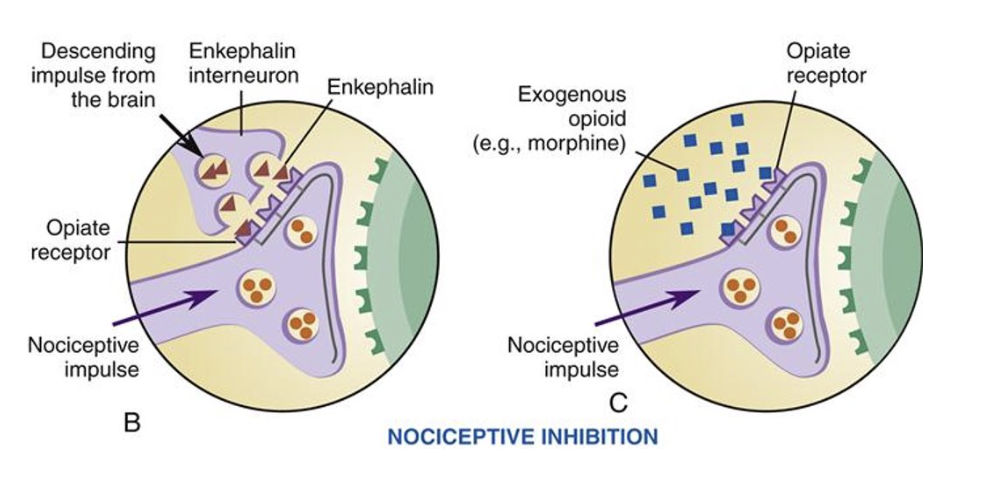
Thermoreceptors detect changes in?
Temperature
Where are thermoreceptors found?
Found in skin/skeletal muscles/liver/hypothalamus
What type of receptors do Thermoreceptors have?
Has Phasic receptors (Adapts quickly to temperature changes)/sends action potential to the brain to feel pain when temperature changes.
Mechanoreceptors are senstive to what?
Physical stimuli (Like your body position)
What do mechanoreceptors contain?
Contain mechanically-gated ion channels that open/close from stretching/compression/twisting or other distortion to the body
What are the classes of mechanoreceptors?
Tactile receptors
Baroreceptors
Proprioceptors
Tactile receptors detect?
Detect touch (shape/texture), pressure & vibration
What are the 2 types of Tactile receptors?
Fine touch receptors: Very sensitive, detailed info of stimulus, small receptive fields
Crude touch receptors: Less sensitive, give general idea of stimulus, has large receptive field
Free nerve endings detect what? have what type of receptors? and what type of receptive field?
Detect touch/pressure
Tonic receptors (Slow to adapt)
Small receptive fields
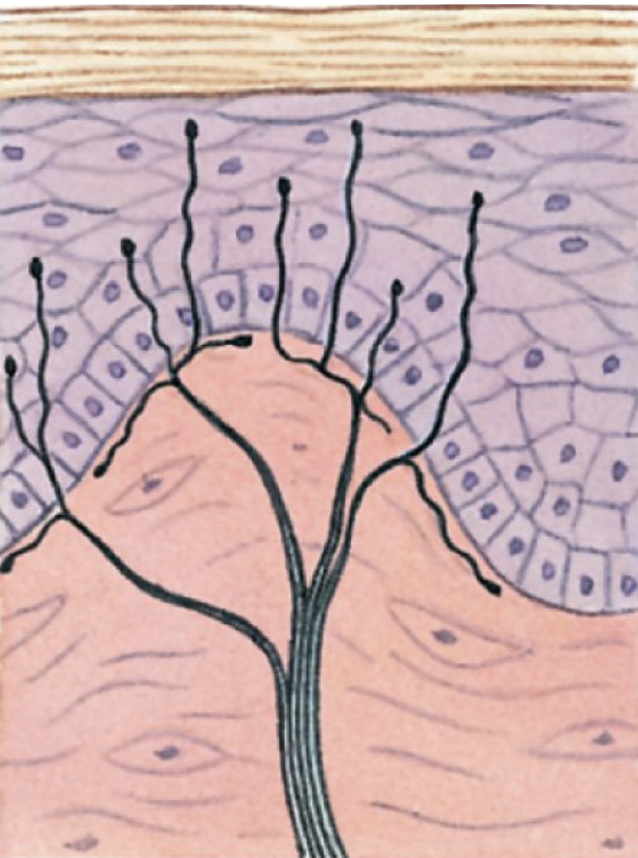
Root hair plexus detect what? have what receptors?
Detect movement near hair
Phasic receptors (Quick to adapt)
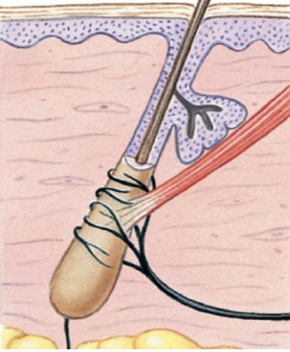
Tactile discs (Skin) detect what? and what type of receptor & what receptive field?
Detect fine-touch pressure
Tonic receptors & small receptive field
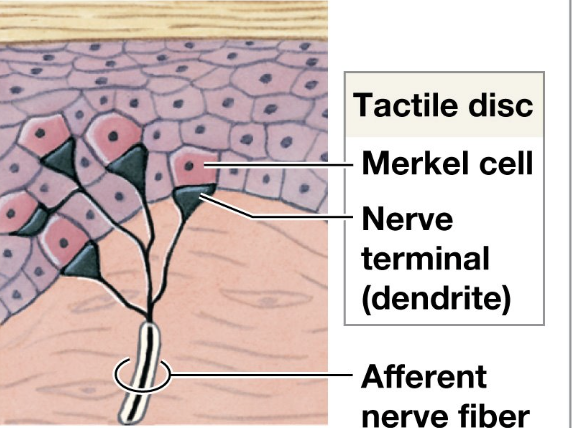
Bulbous Ruffini Corpuscles are senstive to what? Have what receptors, and located where?
Sensitive to deep pressure & distortion
Tonic receptors
Located in deep dermis
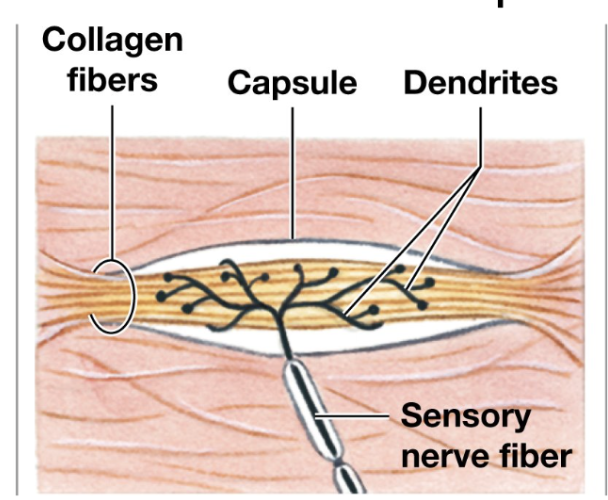
Lamellar Pacinian Corpuscles are senstive to what? Have what type of receptors?
Sensitive to deep pressure & vibrations
Phasic receptors
How do you identify Lamellar Pacinian Corpuscles?
Has a single dendrite within series of layers of collagen
Baroreceptors (Fluid) detect what? and found in what?
Detect changes in pressure in blood vessels, lungs, and other organs
Found in stretchy tissues like arteries
Proprioceptors sense what? and what are the 3 types?
Sense position and movement
3 Types:
Muscle spindles: Sense muscle length
Golgi tendon organs: Sense tension in tendons
Joint receptors: Detect pressure and movement in joints
Chemoreceptors respond to what? and what type of receptors that it has?
Respond to substances that are dissolved in body fluids
Phasic receptors that monitor pH, CO2, O2 levels in blood
What is a sensory Homunculus?
A map in the brain showing which areas control sensations in different body parts
Areas with more sensory neurons (like hands and face) appear larger on map
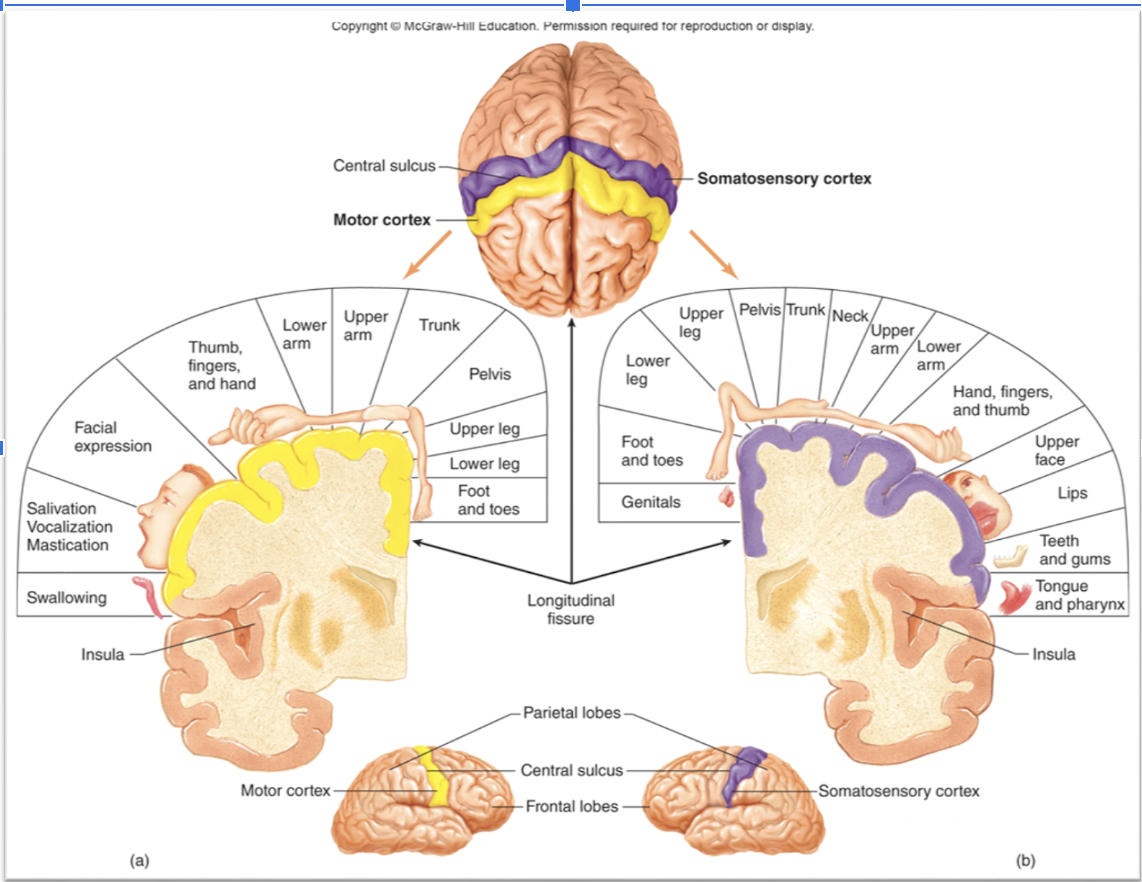
What is a motot homunculus?
Map for movement
Shows areas of the brain responsible for controlling specific muscles
Body parts needing fine control (hands, face) take up larger areas.
